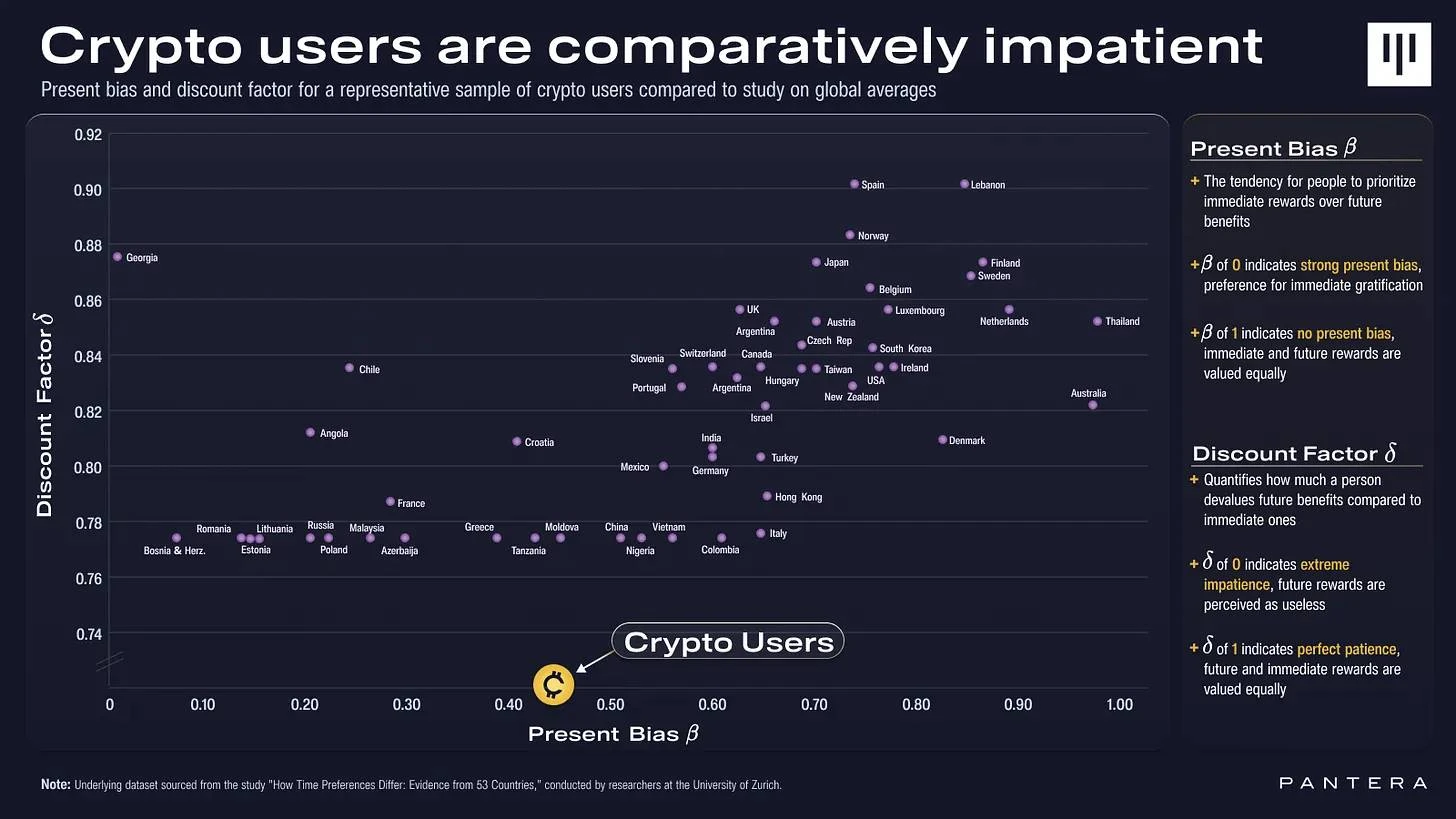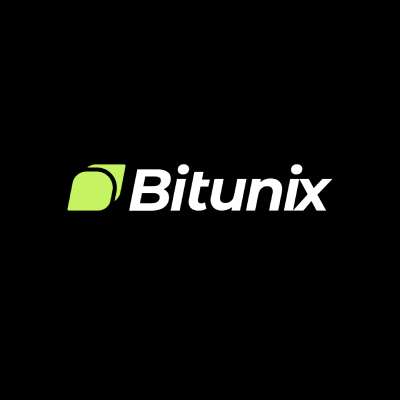原文作者: 保罗·维拉迪塔基特
原文翻译:TechFlow
加密货币用户需要干预吗?
-
Pantera 研究实验室的一项研究发现,加密货币用户表现出较高的当前偏好和较低的折扣因素,表明他们强烈偏好即时满足。
-
准双曲线折现模型以现时偏差(ꞵ)和折现因子(?)等参数为特征,有助于理解个人倾向于即时回报而非未来收益,这种行为在动荡且投机性的加密货币市场中尤为明显。
-
该研究可用于优化代币分配,例如空投以奖励早期用户、分散治理和营销新产品。
介绍
硅谷创业故事中的一个经典例子是 Paypal 决定向使用其产品的用户支付 $10。其背后的逻辑是,如果你能付钱让人们加入,最终网络价值将足够高,以至于新人会免费加入,你就可以停止付费。这似乎确实奏效了,因为 PayPal 能够停止付费并继续增长,从而引导网络效应。

在加密货币领域,我们采用了这种方法并加以扩展,使用空投不仅向人们支付加入费用,而且通常要求他们在一段时间内使用我们的产品。
拟双曲线折现模型
空投代币已经成为奖励早期采用者、去中心化协议治理和推广新产品的多面工具。特别是,在确定谁应该获得奖励以及他们的努力的价值时,制定分配标准已经成为一门艺术。在这种背景下,代币分配的数量和时间(通常通过归属期或逐步释放等机制)起着重要作用。这些决定应该基于系统分析,而不是依赖猜测、情感或先例。使用更量化的框架可以确保公平并与长期目标战略保持一致。
拟双曲线贴现模型 提供了一个数学框架,用于探索个人在不同时间点权衡奖励时所做的选择。其应用在冲动和时间不一致显著影响决策的领域尤其重要,例如财务决策和健康相关行为。
该模型由两个特定参数驱动:当前偏好(ꞵ)和折扣因子(?)。
当前偏好(ꞵ):
此参数衡量个人优先考虑即时奖励而非远期奖励的倾向。其值介于 0 和 1 之间,其中 1 表示当前没有偏好,反映对未来奖励的平衡、时间一致性评估。值越接近 0,表示当前偏好越强烈,表明对即时奖励的偏好越高。
例如,在选择今天取出 $50 还是一年后取出 $100 时,当前偏好较高(接近于 0)的人会倾向于立即取出 $50,而不是等待更大的金额。
折扣因子(?):
此参数描述了未来奖励的价值随着实现时间的增加而下降的速度,同时考虑到其感知价值会随着延迟而自然下降。折扣因子在较长的多年间隔内更准确地量化。在短期内(不到一年)评估两个选项时,该因子表现出相当大的可变性,因为即时情况可能会不成比例地影响感知。
对于一般人群,研究表明折扣系数通常在 0.9 左右。然而,在赌博倾向较强的群体中,这个值通常要低得多。 研究 表明习惯性赌徒的平均折扣系数略低于 0.8,而问题赌徒的折扣系数接近 0.5。
使用上述术语,我们可以将在时间 t 获得奖励 x 的效用 U 表示如下:
U(t) = tU(x) U(t) = tU(x)
该模型捕捉到了奖励的价值随时间的变化方式:即时奖励的价值取决于全部效用,而未来奖励则根据当前偏好和指数衰减进行调整。
实验
去年,Pantera 研究实验室进行了一项研究,以量化加密货币用户的行为倾向。我们用两个简单的问题调查了参与者 设计用于 衡量他们对即时支付与未来价值的偏好。
这种方法有助于我们确定 ꞵ 和 ? 的代表值。我们的研究发现,加密货币用户的代表性样本表现出略高于 0.4 的当前偏好和明显较低的折扣因子。

研究表明,加密货币用户 高于平均水平 当前偏好和低折扣因素,表明他们往往没有耐心,更喜欢即时满足而不是未来的收益。
这可以归因于加密货币环境中的几个相互关联的因素:
-
周期性市场行为:加密货币市场以其波动性和周期性而闻名,代币的价值经常会急剧波动。这种周期性会影响用户行为,因为许多人习惯于驾驭这些周期,而不是采用传统金融中更常见的长期投资策略。频繁的起伏可能会导致用户对未来价值的低估,担心潜在的下跌可能会抹去利润。
-
代币污名:调查特别询问了代币及其预期未来价值,这可能凸显了代币交易中根深蒂固的污名。与周期性和投机相关的代币估值污名强化了人们对长期投资的谨慎态度。此外,如果调查衡量法定货币或其他形式的奖励,结果可能与全球平均水平更一致,这表明奖励的性质可能会显著影响观察到的折扣行为。
-
加密货币应用的投机性:当今的加密货币生态系统深深植根于投机和交易,这些特征在其最成功的应用中尤为普遍。这种倾向表明,当前用户绝大多数更喜欢投机平台,这种偏好反映在调查结果中,这些平台表现出对即时财务收益的强烈偏好。
尽管研究结果可能与典型的人类行为规范不同,但它们反映了当前加密货币用户群体的特征和倾向。这种区别对于设计空投和代币分发的项目尤其重要,因为了解这些独特的行为可以实现更具战略性的规划和奖励系统结构。
例如,Solana 上的永久合约 DEX Drift 最近推出了其原生代币 DRIFT。 漂移 团队在其代币分发策略中加入了时间延迟机制,为在代币发布后等待 6 小时领取空投的用户提供双倍奖励。时间延迟旨在缓解空投早期通常由机器人造成的拥堵,并通过减少早期卖家的激增来帮助稳定代币表现。
事实上,只有 7.5千 或 15%(截至撰写本文时)的潜在接收者没有等待 6 小时来领取双倍奖励。根据我们的发现,Drift 可以延迟几个月,从统计上看应该可以满足大多数最终用户的需求。
本文来源于网络:Pantera Research:加密货币用户缺乏耐心,即时满足感大于未来收益
简言之,自本月初以来,Neo 的价格一直处于上升趋势,目前正试图突破 $23,创下今年迄今的新高。MACD 指标接近于观察到看涨交叉,这将使结果转化为收益。夏普比率还显示,目前风险调整后的回报很有吸引力,这将吸引投资者。尽管山寨币面临更广泛的市场线索的影响,但 Neo (NEO) 的价格仍保持稳定。因此,这种加密货币似乎正在为从未来几天可能发生的近期损失中复苏做准备。Neo 是一个不错的选择加密市场事件严重影响 Neo 的价格,因为山寨币是一种相对较小的市值资产。这使得它容易受到突然飙升和重大……







